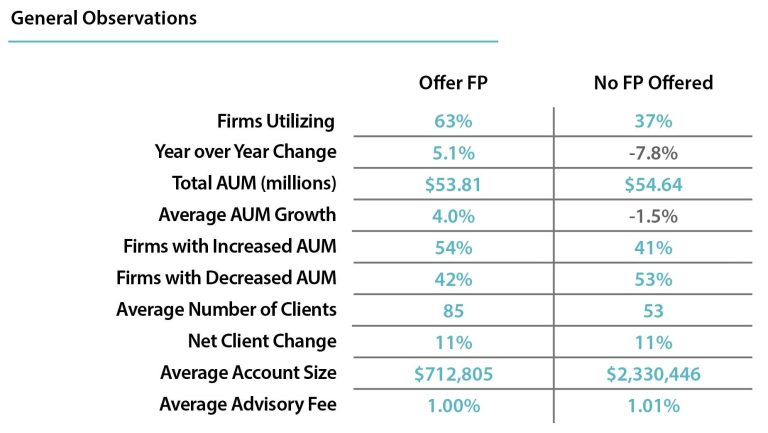This is the fifth of a series of blog posts in the coming weeks that provide select insights from our 2015 Registered Investment Adviser (RIA) Industry Overview Report that will be released later this year. This proprietary RIA in a Box study used detailed survey responses from 1,198 advisory firms paired with publicly accessible data provided on the Securities and Exchange (SEC) website.* The goal of this annual study is to understand different options that comprise each firm characteristic, and to determine whether specific characteristics affect the growth, size, or operational efficiency of an RIA firm.
Technology Adoption: Number of Systems Used
As an RIA grows to serve more clients, administrative overhead can become a burden and consumes more and more time, often at the expense of the client experience. Many new technology solutions have come to market, however, that enable RIAs to operate more efficiently and to provide a better client relationship and investment experience. For the purposes of this study, we explored these four investment adviser technology categories:
- Customer Relationship Management (CRM) systems enable a firm to efficiently manage and measure its interactions with prospects and clients using email automation, call logging, and activity tracking functionality.
- Financial Planning Systems (FPS) vary widely in their feature sets but share the common goal of providing the user with a modeling tool to forecast various scenarios based on a series of inputs defining a client’s current financial situation and future goals.
- Portfolio Management / Reporting (PM/Rep) systems provide varying levels asset allocation, performance display, and client billing features.
- Document Storage (DOC) systems provide cloud-based file storage to assist with file-sharing, version control, and compliance with document retention requirements.
Selected Observations From Our Survey
- Firms with smaller average account sizes and higher client volumes tend to use more systems
- RIAs with two or more systems were more likely to grow assets under management (AUM) than those with zero or more
- As a firm uses more systems, its AUM growth rate also accelerates
- Over half of RIAs with AUM of $10 million or more use two or more systems
- Over half of RIAs with AUM of $50 million or more use three or more systems
The following chart further explores the characteristics of investment advisory firms utilizing 0, 1, 2, 3, or 4 of the systems discussed above:

It’s interesting to note that 25% of firms surveyed do not use any investment adviser technology system. The average account size of these “tech laggards” is significantly higher than firms more aggressively adopting technology which leads to two possible conclusions:
- These firms are more institutional in nature and thus these systems have less value.
- These firms offer a more customized and labor intensive approach to serve a much more affluent client.
However, given that this group of tech laggards was the only cohort to experience negative annual AUM growth (-3.7% vs. +0.8% to +8.4%) and also trailed its peers in net client change (+7% vs. +10% to +14%), perhaps traditional thoughts on why technology may be less important to this group are flawed. In other words, aggressive technology adoption may be just as important to this type of RIA firm than previously assumed. This will be an area of further exploration in future studies.
Technology Adoptions: Types of Systems Used
Before selecting specific technology vendors, an RIA must determine which systems to prioritize. Here is a brief introduction to what types of systems investment advisory firms are likely to adopt:
Selected Observations From Our Survey
- CRM and Portfolio Management / Reporting systems are often the first to be adopted
- Firms that adopted any type of technology system were more likely to experience AUM growth
- All systems surveyed have a less than 50% RIA industry adoption rate

One interesting observation is that investment advisory firms that utilize financial planning software have a smaller average account size compared to firms adopting other types of technology systems. In addition, this same group of firms also experienced the highest average annual AUM growth (+6.3%) while at the same time experiencing a positive net client change (+11%) relatively in-line with the other groups. Thus, it would appear that a larger portion of this group’s AUM growth came from increasing the level of assets from existing clients. Perhaps by providing a more holistic wealth management experience with the assistance of financial planning software, this group was able to build deeper client relationships and ultimately increase wallet share. This will be an area of further exploration in future studies.
The positive effects of adding a technology system, regardless of the system type or current number of systems used, are significant. With each system adopted, firms appear more likely to grow faster and realize greater operational efficiencies. The most progressive RIA firms view technology purchases as investments rather than costs to be minimized. As we look forward to exploring and sharing in subsequent material, adoption of technology systems in general can be a competitive differentiator and adopting certain best-in-breed systems may dramatically enhance a firm’s ability to grow.
Be sure to check out our previous posts from our most recent investment adviser industry study:
- RIA Industry Study: The Profile of Firms That Offer Financial Planning
- RIA Industry Study: Outsourced vs. In-House Portfolio Management
- RIA Industry Study: Active and Passive Portfolio Management Styles
- RIA Industry Study: Comparing 2014 and 2015 AUM Growth Rates
Note: The average investment advisory fee charged by the RIA ?firm may not include additional underlying investment manager or product fees. *Source: SEC and state investment adviser firm reports as of June 8, 2016 available on the SEC Investment Adviser Public Disclosure (IAPD) website.
